Interactive Effects of Tillage Systems and Nitrogen Fertilizer Rates on the Performance of Mustard-Boro-aman Rice Cropping Systems under Conservation Agriculture Practices
Abstract
:1. Introduction
2. Materials and Methods
2.1. Description of the Site and Climatic Conditions
2.2. Treatments and Design
2.3. Crop Management
2.3.1. Mustard
2.3.2. Rice
2.4. Data Collection
2.4.1. Mustard
2.4.2. Rice
2.5. Soil and Nutrient Data
2.6. Systems Rice Equivalent Yield (SREY) Calculation
2.7. Economic Analysis
2.8. Statistical Analysis
3. Results
3.1. Rice Performance
3.1.1. Aman
3.1.2. Boro
3.2. Mustard Performance
3.3. System Rice Equivalent Yield (SREY)
3.4. Soil Physical and Chemical Properties and Soil Nutrient Parameters
3.5. Economics
4. Discussion
4.1. Crop Performance across Tillage Systems
4.2. Crop Performance across N Levels
4.3. Economic Performance
4.4. Effect of CA on Soil Performance
5. Conclusions
Author Contributions
Funding
Institutional Review Board Statement
Informed Consent Statement
Data Availability Statement
Acknowledgments
Conflicts of Interest
References
- Kassam, A.; Friedrich, T.; Shaxson, F.; Pretty, J. The spread of Conservation Agriculture: Justification, sustainability and uptake. Int. J. Agric. Sustain. 2009, 7, 292–320. [Google Scholar] [CrossRef]
- Hobbs, P.R.; Sayre, K.; Gupta, R. The role of conservation agriculture in sustainable agriculture. Philos. Trans. R. Soc. London B Biol. Sci. 2008, 363, 543–555. [Google Scholar] [CrossRef]
- Haque, M.; Bell, R.; Islam, M.; Rahman, M. Minimum tillage unpuddled transplanting: An alternative crop establishment strategy for rice in conservation agriculture cropping systems. Field Crop. Res. 2015, 185, 31–39. [Google Scholar] [CrossRef]
- Bell, R.W.; Haque, E.; Jahiruddin, M.; Rahman, M.; Begum, M.; Miah, M.A.M.; Islam, A.; Hossen, A.; Salahin, N.; Zahan, T.; et al. Conservation Agriculture for Rice-Based Intensive Cropping by Smallholders in the Eastern Gangetic Plain. Agriculture 2018, 9, 5. [Google Scholar] [CrossRef] [Green Version]
- Alam, K.; Bell, R.W.; Hasanuzzaman, M.; Salahin, N.; Rashid, M.; Akter, N.; Akhter, S.; Islam, M.S.; Islam, S.; Naznin, S.; et al. Rice (Oryza sativa L.) Establishment Techniques and Their Implications for Soil Properties, Global Warming Potential Mitigation and Crop Yields. Agronomy 2020, 10, 888. [Google Scholar] [CrossRef]
- Ahmmed, S.; Jahiruddin, M.; Razia, S.; Begum, R.A.; Biswas, J.C.; Rahman, A.S.M.M.; Satter, M.A. Fertilizer Recommendation Guide-2018. Bangladesh Agric. Res. Counc. Farmgate Dhaka-P 2018, 1215, 223. [Google Scholar]
- Jahiruddin, M.; Islam, M.R.; Miah, M.A.M. Constraints of Farmer’s Access to Fertilizer for Food Production; Final Report; FAO: Mymensingh, Bangladesh, 2009. [Google Scholar]
- Salahin, N.; Jahiruddin, M.; Islam, M.; Alam, K.; Haque, M.; Ahmed, S.; Baazeem, A.; Hadifa, A.; EL Sabagh, A.; Bell, R. Establishment of Crops under Minimal Soil Disturbance and Crop Residue Retention in Rice-Based Cropping System: Yield Advantage, Soil Health Improvement, and Economic Benefit. Land 2021, 10, 581. [Google Scholar] [CrossRef]
- Islam, M.A. Conservation Agriculture: Its Effects on Crop and Soil in Rice-Based Cropping Systems in Bangladesh. Ph.D. Thesis, Murdoch University, Perth, Australia, 2016; p. 317. [Google Scholar]
- Alam, M.K. Assessment of Soil Carbon Sequestration and Climate Change Mitigation Potential under Conservation Agriculture Practices in the Eastern Gangetic Plains. Ph.D. Thesis, Murdoch University, Perth, Australia, 2018; p. 335. [Google Scholar]
- Thuy, N.H.; Shan, Y.; Singh, B.; Wang, K.; Cai, Z.; Singh, Y.; Buresh, R.J. Nitrogen Supply in Rice-Based Cropping Systems as Affected by Crop Residue Management. Soil Sci. Soc. Am. J. 2008, 72, 514–523. [Google Scholar] [CrossRef]
- Pan, S.-G.; Huang, S.-Q.; Zhai, J.; Wang, J.-P.; Cao, C.-G.; Cai, M.-L.; Zhan, M.; Tang, X.-R. Effects of N Management on Yield and N Uptake of Rice in Central China. J. Integr. Agric. 2012, 11, 1993–2000. [Google Scholar] [CrossRef]
- Jahiruddin, M.; Islam, M.R.; Haque, M.A.; Haque, E.; Bell, R.W. Crop response to nitrogen fertilizer under strip tillage and two residue retention levels in a rice-wheat-mungbean sequence. In Conservation Agriculture in Rice-Based Cropping Systems: Its Effect on Crop Performance. Proceedings of the 6th World Congress of Conservation Agriculture, Winnipeg, Canada, 21–25 June 2014; Conservation Technology Information Centre: Winnipeg, Canada, 2014; pp. 23–24. [Google Scholar]
- Sutapa, K. Nitrogen Requirement for T. Aman Rice under Strip Tillage System at Two Residue Retention Levels. Master’s Thesis, Department of Soil Science, Bangladesh Agricultural University, Mymensingh, Bangladesh, 2014. [Google Scholar]
- Altikat, S.; Celik, A. The effects of tillage and intra-row compaction on seedbed properties and red lentil emergence under dry land conditions. Soil Tillage Res. 2011, 114, 1–8. [Google Scholar] [CrossRef]
- Lampurlanés, J.; Cantero-Martínez, C. Soil bulk density and penetration resistance under different tillage and crop management systems and their relationship with barley root growth. Agron. J. 2003, 95, 526–536. [Google Scholar] [CrossRef]
- Karim, Z.; Rahman, S.M.; Idris, M.; Karim, A.J.M.S. Soil bulk density: A manual for determination of soil physical parameters. In Soils and Irrigation Division; Bangladesh Agricultural Research Council (BARC): Dhaka, Bangladesh, 1988. [Google Scholar]
- Jackson, M.L. Soil Chemical Analysis; Prentice Hall of India Pvt. Ltd.: New Delhi, India, 1973; pp. 38–56. [Google Scholar]
- Piper, C.S. Soil and Plant Analysis; Adelaide University: Adelaide, Australia, 1950. [Google Scholar]
- Bremner, J.M.; Mulvaney, C.S. Total nitrogen. In Methods of Soil Analysis, Part-2, 2nd ed.; Page, A.L., Miller, R.H., Keeney, D.R., Eds.; American Society of Agronomy: Madison, WI, USA, 1982; pp. 599–622. [Google Scholar]
- Olsen, S.R.; Sommers, L.E. Phosphorus. In Methods of Soil Analysis, Part-2, 2nd ed.; Page, A.L., Miller, R.H., Keeney, D.R., Eds.; American Society of Agronomy: Madison, WI, USA, 1982; pp. 403–427. [Google Scholar]
- Black, C.A. Method of Soil Analysis (Part-I and II); American Society of Agronomy Inc.: Madison, WI, USA, 1965. [Google Scholar]
- Fox, R.L.; Olson, R.A.; Rhoades, H.F. Evaluating the Sulfur Status of Soils by Plant and Soil Tests. Soil Sci. Soc. Am. J. 1964, 28, 243–246. [Google Scholar] [CrossRef]
- Lindsay, W.L.; Norvell, W.A. Development of a DTPA soil test for zinc, iron, manganese, and copper. Soil Sci. Soc. Am. J. 1978, 42, 421–428. [Google Scholar] [CrossRef]
- Anjeneyul, V.R.; Singh, S.P.; Paul, M. Effect of competition free periods and techniques and pattern of pearl millet planting on growth and yield of mungbean inter-cropping systems. Indian J. Agron. 1982, 27, 219–226. [Google Scholar]
- Chowdhury, A.K.M.H.U.; Haque, M.E.; Hoque, M.Z. Farmers response towards cultivation of BRRI dhan47 in the coastal saline area. Int. J. Sustain. Agril. Tech. 2012, 8, 13–18. [Google Scholar]
- Pittelkow, C.M.; Liang, X.; Linquist, B.A.; van Groenigen, K.J.; Lee, J.; Lundy, M.E.; van Gestel, N.; Six, J.; Venterea, R.T.; van Kessel, C. Productivity limits and potentials of the principles of conservation agriculture. Nature 2015, 517, 365–368. [Google Scholar] [CrossRef]
- Lundy, M.E.; Pittelkow, C.M.; Linquist, B.A.; Liang, X.; van Groenigen, K.J.; Lee, J.; Six, J.; Venterea, R.T.; van Kessel, C. Nitrogen fertilisation reduces yield declines following no-till adoption. Field Crop Res. 2015, 183, 204–210. [Google Scholar] [CrossRef] [Green Version]
- Choudhary, R.L.; Behera, U.K. Effect of Conservation agriculture and nitrogen management in maize–wheat cropping system: Effect on growth, productivity and economics of wheat. Int. J. Chem. Stud. 2020, 8, 2432–2438. [Google Scholar] [CrossRef]
- Salahin, N.; Alam, M.; Shil, N.; Mondol, A.A.; Alam, M. Effects of tillage practices and nutrient management on crop productivity and profitability in Jute-T. aman rice- onion cropping system. Bangladesh J. Agric. Res. 2019, 44, 387–399. [Google Scholar] [CrossRef] [Green Version]
- Sah, G.; Shah, S.C.; Sah, S.K.; Thapa, R.B.; McDonald, A.; Sidhu, H.S.; Gupta, R.K.; Wall, P.C. Productivity and soil attributes as influenced by resource conservation technologies under rice- wheat system in Nepal. Agron. J. Nepal 2013, 3, 64–72. [Google Scholar] [CrossRef]
- Oyeogbe, A.I.; Das, T.K.; Bandyopadhyay, K.K. Agronomic productivity, nitrogen fertilizer savings and soil organic carbon in conservation agriculture: Efficient nitrogen and weed management in maize-wheat system. Arch. Agron. Soil Sci. 2018, 64, 1635–1645. [Google Scholar] [CrossRef]
- Pittelkow, C.M.; Linquist, B.A.; Lundy, M.E.; Liang, X.; van Groenigen, K.J.; Lee, J.; van Gestel, N.; Six, J.; Venterea, R.T.; van Kessel, C. When does no-till yield more? A global meta-analysis. Field Crop. Res. 2015, 183, 156–168. [Google Scholar] [CrossRef] [Green Version]
- Oyeogbe, A.I.; Das, T.K.; Bhatia, A.; Singh, S.B. Adaptive nitrogen and integrated weed management in conservation agriculture: Impacts on agronomic productivity, greenhouse gas emissions, and herbicide residues. Environ. Monit. Assess. 2017, 189, 247. [Google Scholar] [CrossRef]
- Sapkota, T.B.; Majumdar, K.; Jat, M.L.; Kumara, A.; Bishnoi, D.K.; McDonald, A.J.; Pampolino, M. Precision nutrient management in conservation agriculture based wheat production of North-west India: Profitability, nutrient use efficiency and environmental footprint. Field Crops Res. 2014, 155, 233–244. [Google Scholar] [CrossRef]
- Küstermann, B.; Munch, J.C.; Hülsbergen, K.J. Effects of soil tillage and fertilisation on resource efficiency and greenhouse gas emissions in a longterm field experiment in Southern Germany. Eur. J. Agron. 2013, 49, 61–73. [Google Scholar] [CrossRef]
- Salahin, N. Influence of Minimum Tillage and Crop Residue Retention on Soil Organic Matter, Nutrient Content and Crop Productivity in the Rice-Jute System. Ph.D. Thesis, Bangladesh Agricultural University, Mymensingh, Bangladesh, 2017; p. 246. [Google Scholar]
- Rieger, S.; Richner, W.; Streit, B.; Frossard, E.; Liedgens, M. Growth, yield, and yield components of winter wheat and the effects of tillage intensity, preceding crops, and N fertilisation. Eur. J. Agron. 2008, 28, 405–411. [Google Scholar] [CrossRef]
- Yadav, G.S.; Lal, R.; Meena, R.S.; Babu, S.; Das, A.; Bhowmik, S.N.; Datta, M.; Layak, J.; Saha, P. Conservation tillage and nutrient management effects on productivity and soil carbon sequestration under double cropping of rice in north eastern region of India. Ecol. Ind. 2019, 105, 303–315. [Google Scholar] [CrossRef]
- Alam, K.; Bell, R.W.; Haque, M.E.; Kader, M.A. Minimal soil disturbance and increased residue retention increase soil carbon in rice-based cropping systems on the Eastern Gangetic Plain. Soil Tillage Res. 2018, 183, 28–41. [Google Scholar] [CrossRef]
- Giller, K.E.; Witter, E.; Corbeels, M.; Tittonell, P. Conservation agriculture and smallholder farming in Africa: The heretics’ view. Field Crop. Res. 2009, 114, 23–34. [Google Scholar] [CrossRef]
- Tittonell, P.; Scopel, E.; Andrieu, N.; Posthumus, H.; Mapfumo, P.; Corbeels, M.; van Halsema, G.; Lahmar, R.; Lugandu, S.; Rakotoarisoa, J.; et al. Agroecology-based aggradation-conservation agriculture (ABACO): Targeting innovations to combat soil degradation and food insecurity in semi-arid Africa. Field Crop. Res. 2012, 132, 168–174. [Google Scholar] [CrossRef]
- Sommer, R.; Thierfelder, C.; Tittonell, P.; Hove, L.; Mureithi, J.; Mkomwa, S. Fertiliser use should not be the fourth principle to define conservation agriculture. Field Crops Res. 2014, 169, 145–148. [Google Scholar] [CrossRef]
- Vanlauwe, B.; Wendt, J.; Giller, K.E.; Corbeels, M.; Gerard, B.; Nolte, C. A fourth principle is required to define conservation agriculture in sub-Saharan Africa: The appropriate use of fertiliser to enhance crop productivity. Field Crops Res. 2014, 155, 10–13. [Google Scholar] [CrossRef]
- Zentner, R.; Lafond, G.; Derksen, D.; Campbell, C. Tillage method and crop diversification: Effect on economic returns and riskiness of cropping systems in a Thin Black Chernozem of the Canadian Prairies. Soil Tillage Res. 2002, 67, 9–21. [Google Scholar] [CrossRef]
- Choudhary, M.; Panday, S.; Meena, V.S.; Singh, S.; Yadav, R.; Pattanayak, A.; Mahanta, D.; Bisht, J.K.; Stanley, J. Long-term tillage and irrigation management practices: Strategies to enhance crop and water productivity under rice-wheat rotation of Indian mid-Himalayan Region. Agric. Water Manag. 2020, 232, 106067. [Google Scholar] [CrossRef]
- Alam, M.K.; Salahin, N.; Islam, S.; Begum, R.A.; Hasanuzzaman, M.; Islam, M.S.; Rahman, M.M. Patterns of change in soil organic matter, physical properties and crop productivity under tillage practices and cropping systems in Bangladesh. J. Agric. Sci. 2017, 155, 216–238. [Google Scholar] [CrossRef]
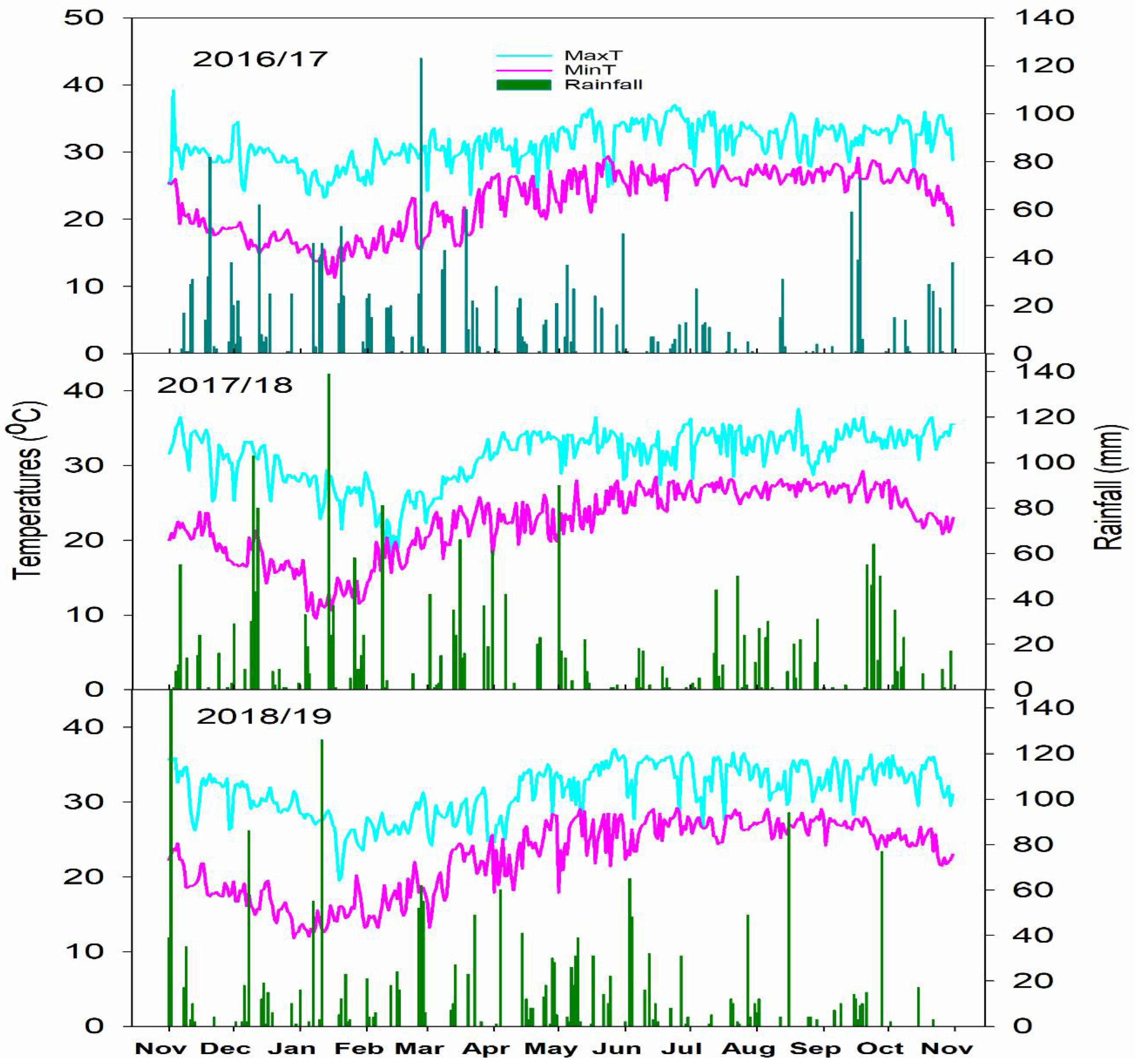
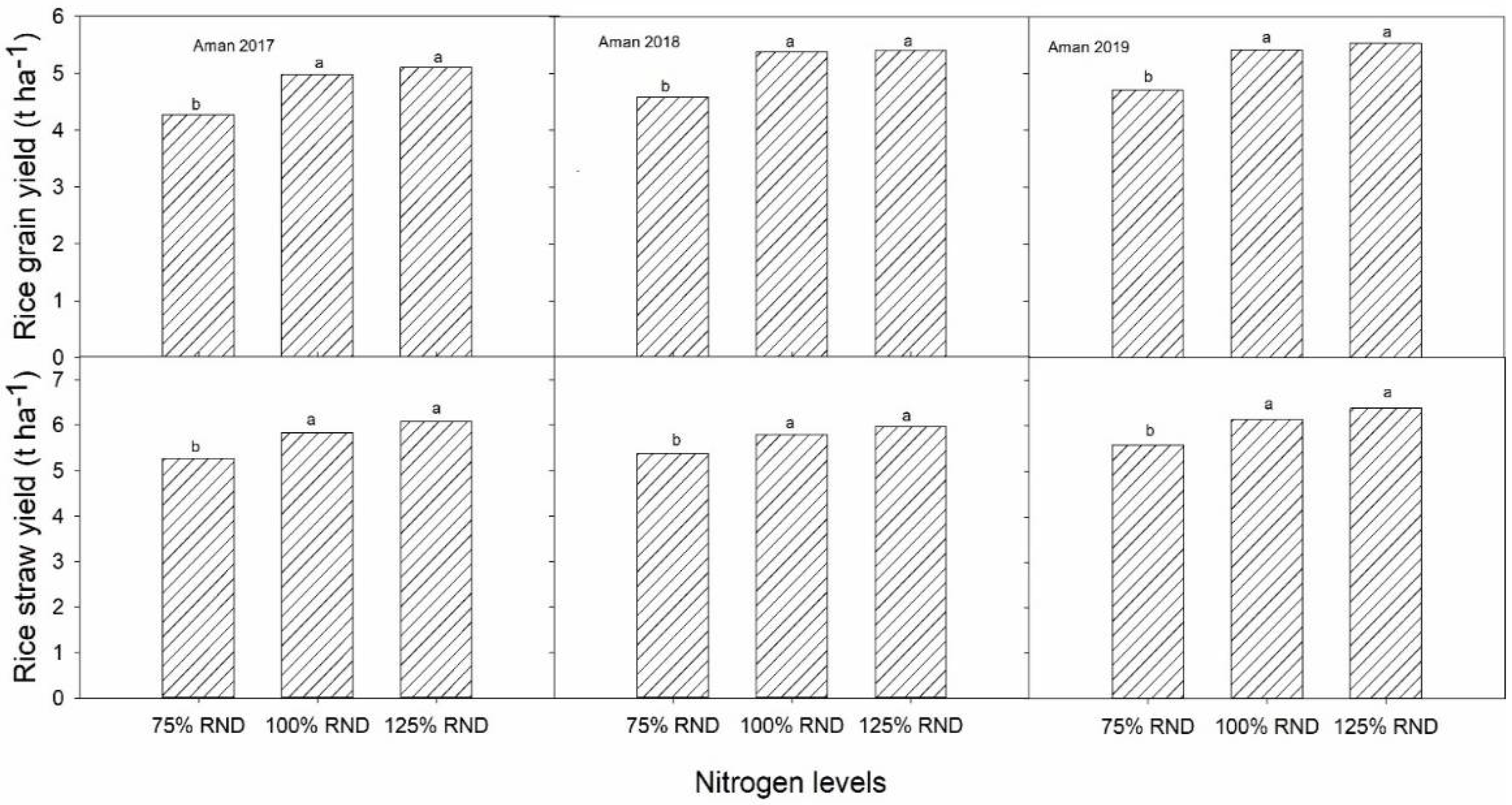



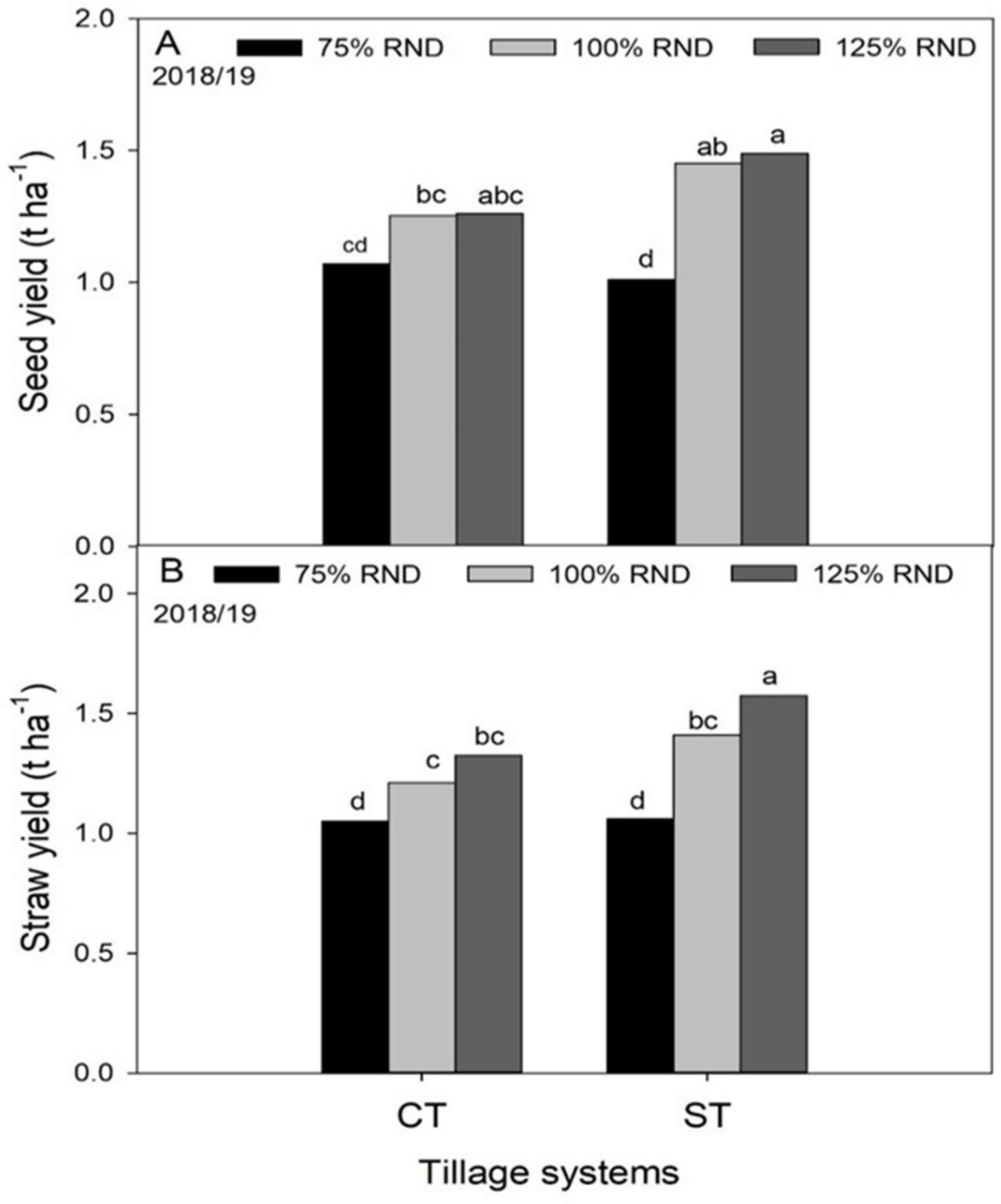
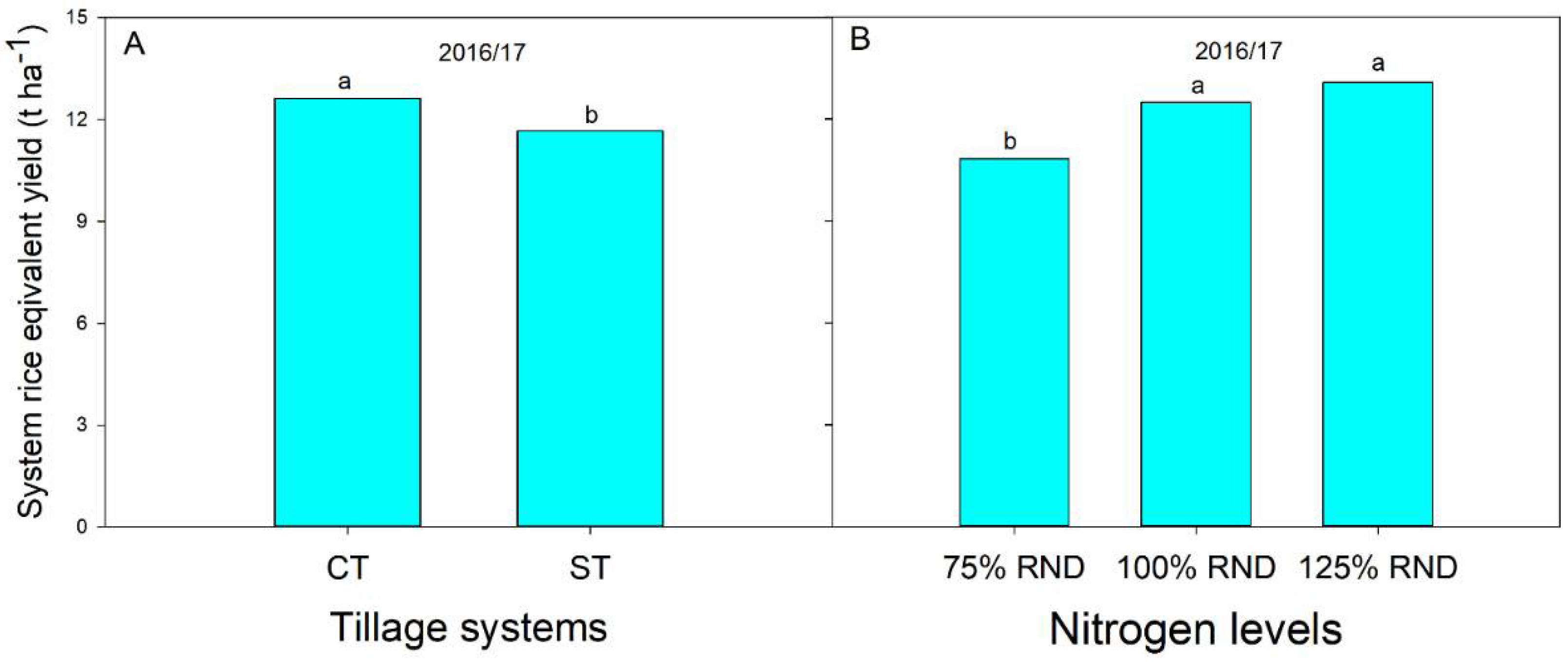
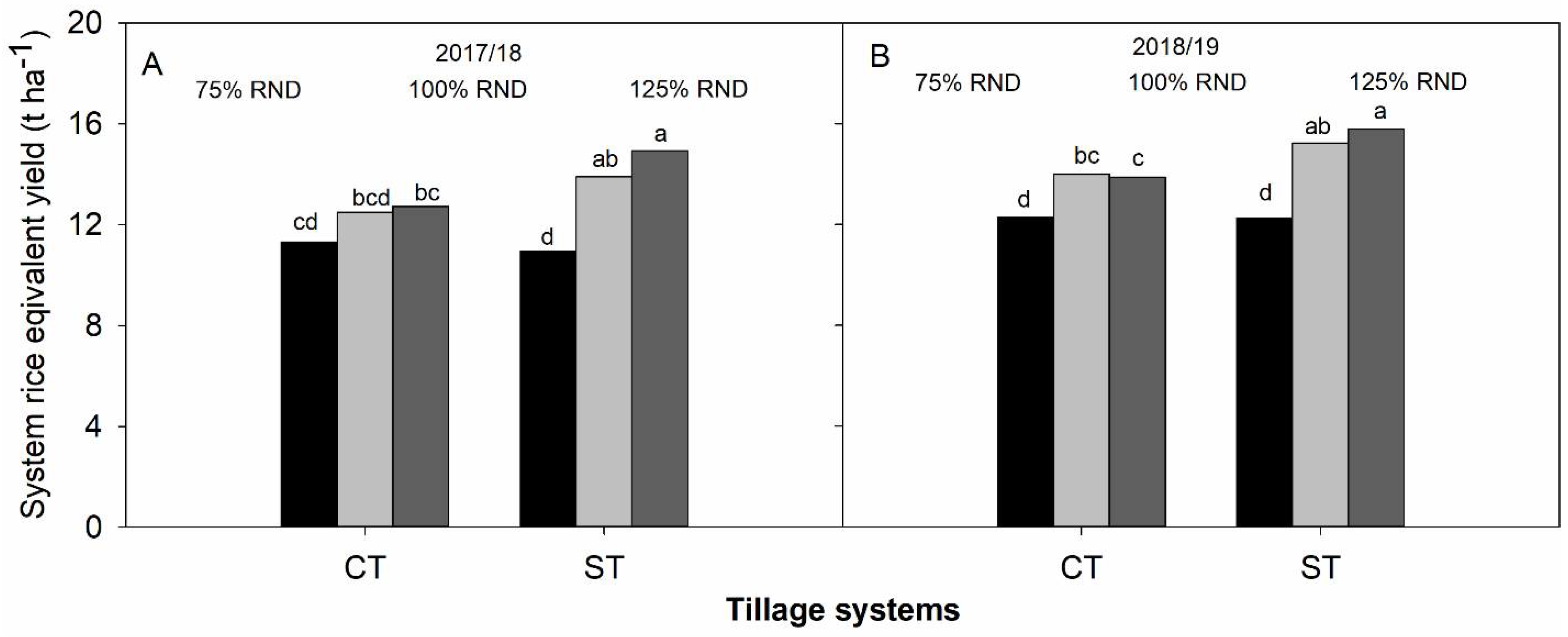
| Soil Depth (cm) | Soil Particle Size | Textural Class | Bulk Density | pH | SOM | Total N | Exchangeable K (meq 100 g soil−1) | Available Other Nutrients | |||||
|---|---|---|---|---|---|---|---|---|---|---|---|---|---|
| Sand% | Silt% | Clay% | (g cm−3) | (%) | P | S | Zn | B | |||||
| (mg kg−1) | |||||||||||||
| 0–15 | 50 | 25 | 25 | Sandy clay loam | 1.40 | 6.3 | 1.02 | 0.055 | 0.12 | 8.0 | 15 | 0.90 | 0.15 |
| Treatments | Treatment Description | |
|---|---|---|
| Tillage practices | Conventional tillage (CT) | Mustard: Full tillage by four passes followed by three ladderings using a power tiller machine. Rice: For both seasons of rice, the land was prepared by puddling using a power tiller machine with four wet-tillage operations followed by three ladderings. |
| Strip tillage (ST) | Mustard: ST was accomplished in a single pass using a power tiller operated seeder (PTOS) that used rotating blades and maintained 30 cm spacing between rows. Rice: In non-puddled fields, 18 h before rice transplanting, the strip was accomplished in one pass with PTOS rotating blades with 20 cm spacing between rows. | |
| N doses (kg ha−1) | N1: 75% of RND | Mustard: Fertilizers such as urea, triple super phosphate, muriate of potash, gypsum, zinc sulphate, and boric acid were applied at the rate of 77-22-54-10-2-1 kg ha−1 of N-P-K-S-Zn-B, respectively. Half of the urea was applied during final land preparation with additional fertilizers, and the other half was applied at 25 days after sowing (DAS). Boro rice: Nutrients N-P-K-S-Zn were applied at the rate of 115-13-72-12-2 kg ha−1, respectively, as a form of fertilizer urea, triple super phosphate, muriate of potash, gypsum, and zinc sulphate. Except for urea, which was applied in three equal splits at 10 days after transplanting (DAT), 30–35 DAT, and 50–55 DAT, fertilizers were applied as a basal dose. Aman rice: Nutrients N-P-K-S-Zn were applied at the rate of 51-10-48-7-1 kg ha−1, respectively, as a form of fertilizer urea, triple super phosphate, muriate of potash, gypsum, and zinc sulphate. Except for urea, which was applied in three equal splits at 10–12, 25–30, and 40–45 DAT, fertilizers were applied as a basal dose. |
| N2: 100% of RND | Mustard: 102 kg ha−1 N as a form of urea. Other fertilizers’ dose and application times were similar to N1. Boro rice: 153 kg N ha−1 as a form of urea fertilizer. Other fertilizers’ dose and application times were similar to N1. Aman rice: 68 kg N ha−1 as a form of urea fertilizer. Other fertilizers’ dose and application times were similar to N1. | |
| N3: 125% of RND | Mustard: 128 kg N ha−1 as a form of urea fertilizer. Other fertilizers’ dose and application times were similar to N1. Boro rice: 191 kg N ha−1 as a form of urea fertilizer. Other fertilizers’ dose and application times were similar to N1. Aman rice: 85 kg N ha−1 as a form of urea fertilizer. Other fertilizers’ dose and application times were similar to N1. | |
| Source of Variance | Plant Height | Productive Tillers Hill−1 | Panicle Length | Filled Grain Panicle−1 | Unfilled Grain Panicle−1 | 1000-Grain Weight | Grain Yield | Straw Yield |
|---|---|---|---|---|---|---|---|---|
| Aman | ||||||||
| Year | NS | 0.0001 | NS | NS | <0.0001 | NS | 0.0007 | <0.0001 |
| Tillage (T) | NS | NS | NS | NS | NS | NS | NS | NS |
| N levels (N) | <0.0001 | <0.0001 | <0.0001 | <0.0001 | 0.0005 | 0.023 | <0.0001 | <0.0001 |
| T × N | NS | NS | NS | NS | NS | NS | NS | NS |
| Boro | ||||||||
| Year | 0.008 | <0.0001 | <0.0001 | NS | NS | NS | <0.0001 | <0.0001 |
| Tillage | NS | NS | NS | NS | NS | NS | NS | NS |
| N levels | <0.0001 | <0.0001 | <0.0001 | <0.0001 | NS | NS | 0.021 | <0.0001 |
| Tillage × N levels | NS | NS | NS | NS | NS | NS | NS | NS |
| N Levels | Plant Height (cm) | Productive Tillers Hill−1 | Panicle Length (cm) | Filled Grain Panicle−1 | Unfilled Grain Panicle−1 | 1000-Grain Weight (gm) | ||||
|---|---|---|---|---|---|---|---|---|---|---|
| Average | 2017 | 2018 | 2019 | Average | Average | 2017 | 2018 | 2019 | 2019 | |
| 75% RND | 104 c | 9.3 b | 10.5 c | 9.5 b | 26.8 b | 92 b | 44 b | 41 b | 36 b | 27 b |
| 100% RND | 109 b | 10.5 ab | 12.4 b | 10.6 ab | 27.6 a | 115 a | 45 b | 43 b | 41 b | 28 ab |
| 125% RND | 113 a | 11.2 a | 13.8 a | 11.5 a | 28.1 a | 121 a | 59 a | 57 a | 43 a | 28 ab |
| N Levels | Plant Height (cm) | Productive Tiller Hill−1 | Panicle Length (cm) | Filled Grain Panicle−1 | ||||||||
|---|---|---|---|---|---|---|---|---|---|---|---|---|
| Y1 | Y2 | Y3 | Y1 | Y2 | Y3 | Y1 | Y2 | Y3 | Y1 | Y2 | Y3 | |
| 75% RND | 95 b | 88 b | 84 c | 12.7 b | 16.9 b | 10.3 b | 23.9 b | 22.2 b | 24.6 b | 98.3 b | 96.2 b | 95 b |
| 100% RND | 99 a | 94 a | 93 b | 13.2 b | 17.7 ab | 12.7 a | 25.8 ab | 23.7 a | 26.4 a | 106 a | 109.8 a | 106 a |
| 125% RND | 101 a | 95 a | 102 a | 14.8 a | 19.1 a | 14.0 a | 26.3 a | 24.1 a | 27.4 a | 107 a | 119.3 a | 111 a |
| Source of Variance | Plant Height | Branch Plant−1 | Siliqua Plant−1 | Seed Siliqua−1 | 1000-Grain Weight | Root Weight | Seed Yield | Straw Yield | System Rice Equivalent Yield |
|---|---|---|---|---|---|---|---|---|---|
| Year | <0.0001 | NS | 0.0003 | NS | <0.0001 | NS | <0.0001 | <0.0001 | <0.0001 |
| Tillage (T) | 0.0248 | <0.0001 | NS | 0.0095 | NS | <0.0001 | 0.0171 | <0.0001 | 0.03 |
| N levels (N) | 0.0004 | <0.0001 | 0.0005 | 0.0002 | NS | <0.0001 | <0.0001 | <0.0001 | <0.0001 |
| T × N | 0.03 | 0.01 | 0.03 | NS | NS | NS | 0.002 | 0.04 | 0.04 |
| Plant Height (cm) | Branch Plant−1 | Siliqua Plant−1 | Seed Siliqua−1 | Root Weight | |||||||
|---|---|---|---|---|---|---|---|---|---|---|---|
| Tillage System | 2016/17 | 2017/18 | 2016/17 | 2017/18 | 2016/17 | 2017/18 | 2016/17 | 2017/18 | 2016/17 | 2017/18 | 2018/19 |
| CT | 94 a | 76 a | 6.5 | 5.8 b | 49.0 | 46.9 b | 24 | 25.2 b | 1.6 b | 1.3 b | 1.4 b |
| ST | 86 b | 73 b | 6.7 | 7.4 a | 47.4 | 53.4 a | 26 | 28.7 a | 2.0 a | 1.9 a | 2.1 a |
| N levels | |||||||||||
| 75% RND | 87 b | 69 b | 6.0 b | 5.8 b | 45.2 b | 45.2 b | 22 b | 25.5 b | 1.4 b | 1.5 b | 1.4 b |
| 100% RND | 89 b | 73 ab | 6.7 a | 7.0 a | 49.9 a | 51.8 a | 25 a | 27.1 ab | 1.8 ab | 1.7 a | 1.8 a |
| 125% RND | 93 a | 76 a | 6.9 a | 7.1 a | 51.4 a | 53.4 a | 27 a | 28.2 a | 2.1 a | 1.8 a | 2.1 a |
| Source of Variance | BD | Soil Penetration | OM | TN | P | K | S | Zn | B | ||
|---|---|---|---|---|---|---|---|---|---|---|---|
| PR 30 | PR 60 | Harvest | |||||||||
| Tillage (T) | <0.0001 | <0.0001 | 0.007 | <0.0001 | <0.0001 | <0.0001 | <0.0001 | <0.0001 | <0.0001 | NS | 0.001 |
| N levels (N) | NS | NS | NS | NS | NS | NS | NS | NS | NS | NS | NS |
| T × N | NS | NS | NS | NS | NS | NS | NS | NS | NS | NS | NS |
| Tillage Systems | Soil Penetration | BD (g cm−3) | OM (%) | TN (%) | P (mg kg−1) | K (meq 100 g soil−1) | S (mg kg−1) | Zn (mg kg−1) | B (mg kg−1) | ||
|---|---|---|---|---|---|---|---|---|---|---|---|
| 30 DAS | 60 DAS | Harvest | |||||||||
| CT | 2.22 a | 2.59 a | 2.74 a | 1.44 a | 1.01 b | 0.054 b | 9.67 b | 0.11 b | 16.06 b | 1.01 | 0.17 b |
| ST | 1.22 b | 1.57 b | 1.54 b | 1.40 b | 1.16 a | 0.062 a | 12.94 a | 0.19 a | 18.83 a | 1.03 | 0.22 a |
| Total Production Cost (USD) | |||
|---|---|---|---|
| 2016/17 | 2017/18 | 2018/19 | |
| Tillage systems | |||
| CT | 2400 a | 2447 a | 2368 a |
| ST | 2365 b | 2350 b | 2285 b |
| N levels | |||
| 75% RND | 2313 c | 2328 c | 2257 c |
| 100% RND | 2389 b | 2404 b | 2321 b |
| 125% RND | 2446 a | 2461 a | 2401 a |
| Total Gross Return (USD) | Total Net Profit (USD) | ||||||
|---|---|---|---|---|---|---|---|
| 2016/17 | 2017/18 | 2018/19 | 2016/17 | 2017/18 | 2018/19 | ||
| Tillage Systems | N Levels | ||||||
| CT | 75% RND | 4049 cd | 3996 cd | 4325 c | 1726 bc | 1628 c | 2034 c |
| 100% RND | 4788 a | 4410 bc | 4901 b | 2375 a | 1956 bc | 2530 bc | |
| 125% RND | 4894 a | 4493 bc | 4877 b | 2429 a | 1973 bc | 2434 c | |
| ST | 75% RND | 3881 d | 3868 d | 4308 c | 1578 c | 1486 c | 2084 c |
| 100% RND | 4299 bc | 4864 ab | 5287 ab | 1934 bc | 2413 ab | 3017 ab | |
| 125% RND | 4567 ab | 5167 ab | 5438 ab | 2140 ab | 2647 ab | 3086 ab | |
Publisher’s Note: MDPI stays neutral with regard to jurisdictional claims in published maps and institutional affiliations. |
© 2022 by the authors. Licensee MDPI, Basel, Switzerland. This article is an open access article distributed under the terms and conditions of the Creative Commons Attribution (CC BY) license (https://creativecommons.org/licenses/by/4.0/).
Share and Cite
Salahin, N.; Alam, M.K.; Shil, N.C.; Mondol, A.T.M.A.I.; Alam, M.J.; Kobeasy, M.I.; Gaber, A.; Ahmed, S. Interactive Effects of Tillage Systems and Nitrogen Fertilizer Rates on the Performance of Mustard-Boro-aman Rice Cropping Systems under Conservation Agriculture Practices. Agronomy 2022, 12, 1671. https://doi.org/10.3390/agronomy12071671
Salahin N, Alam MK, Shil NC, Mondol ATMAI, Alam MJ, Kobeasy MI, Gaber A, Ahmed S. Interactive Effects of Tillage Systems and Nitrogen Fertilizer Rates on the Performance of Mustard-Boro-aman Rice Cropping Systems under Conservation Agriculture Practices. Agronomy. 2022; 12(7):1671. https://doi.org/10.3390/agronomy12071671
Chicago/Turabian StyleSalahin, Nazmus, Md. Khairul Alam, Nirmal Chandra Shil, Abu Taher Mohammad Anwarul Islam Mondol, Md. Jahangir Alam, Mohamed I. Kobeasy, Ahmed Gaber, and Sharif Ahmed. 2022. "Interactive Effects of Tillage Systems and Nitrogen Fertilizer Rates on the Performance of Mustard-Boro-aman Rice Cropping Systems under Conservation Agriculture Practices" Agronomy 12, no. 7: 1671. https://doi.org/10.3390/agronomy12071671
APA StyleSalahin, N., Alam, M. K., Shil, N. C., Mondol, A. T. M. A. I., Alam, M. J., Kobeasy, M. I., Gaber, A., & Ahmed, S. (2022). Interactive Effects of Tillage Systems and Nitrogen Fertilizer Rates on the Performance of Mustard-Boro-aman Rice Cropping Systems under Conservation Agriculture Practices. Agronomy, 12(7), 1671. https://doi.org/10.3390/agronomy12071671










